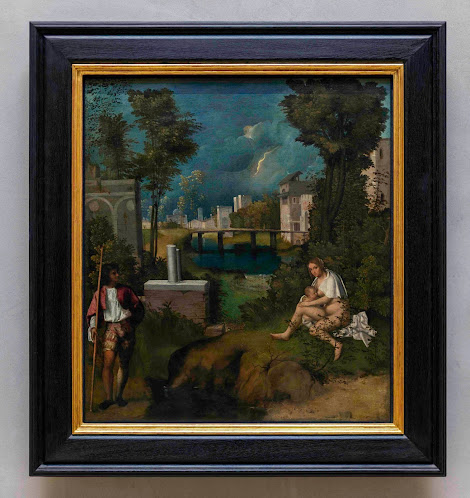Italian and Northern Renaissance Blog
Giorgione, The Tempest
The Painting, and the Painter
For this assignment I chose Giorgione's oil painting The Tempest. It's believed it was painted between 1505 and 1508 in Venice, Italy. Sources were unclear if this was by commission, but the first owner is supposed to have been Gabriele Vendramin, a wealthy soap merchant and nobleman from Venice. This painting, along with other works by Giorgione and other contemporary artists and various antiquities adorned Vendramin's palace, signs of his opulence and appreciation for art. Giorgione's works, including this one, were catalytic in the use of landscapes during the Renaissance. He bore much mimicry; some pieces can hardly be discerned from his own work. He died of plague in 1510 at 33 years of age, young even for those times.
My Thoughts
This is an astounding piece of art, even to a near philistine such as myself. The figures are very lifelike, and though my eye is prone to darting across this work the people are the main focus of the painting, an aspect of humanism. The tones create shadows that work with the perspective to give the piece a photographic feel where you can see the distance between the foreground and the impending storm in the background, with the river and city in between. The vertical, or near vertical, lines of the trees tend to focus my eyes near the people in the foreground, but the contrast of the lightning tears my eyes from the people and drags me across the river and the bridge. Maybe it's not lightning, maybe it's where the sun is shining through an unseen hole in the clouds and onto that particular cloud. Reason for hope or reason for fear? The vividness of the leaves on the trees brings me scurrying around even more, it's like the painting is demanding I take in every detail at once. The storm gives me a feeling of impending doom, much like Aivazovsky's Ninth Wave here. But like the sunny sky in The Ninth Wave, that possible sunshine on the cloud through what might be a break in the gloom above it lends itself to the possibility of a sunny day.
The presence of new life in the infant is a sign of hope as well, making me believe the child may have a chance at a better life than that of his mother, nearly naked in the woods. The look of ambivalence she has towards the man leads me to believe that he could be a danger to her or a help, but she wouldn't be surprised either way. But her eyes looking at me are almost asking for help, though she may not actually expect it. He's pondering her state, not surprised either, but maybe puzzled. Do they know each other? Is that his baby? Unlikely, as X rays of the painting show that in his place was originally another woman, nude, washing her feet in the water. That makes an entirely different scene of this. Were they intended to be destitute sisters? Why the change?
I would accept a print of this painting as a gift for sure. I don't reckon I'd spend my own money, but if gifted a print I'd hang it in my shop.
Dr. James R. Jewitt, "Giorgione, The Tempest," in Smarthistory, April 17, 2020, accessed June 13, 2023, https://smarthistory.org/giorgione-the -tempest/.
Wethey, Harold E. “Giorgione.” Encyclopædia Britannica, 4 May 1999, www.britannica.com/biography/Giorgione#ref50145.



I love this painting and would relish the idea of seeing it in person in Venice. Giorgione provided an exemplary example of Renaissance landscape painting and naturalism in his subjects. The rich colors and texture of the clouds in the skies almost seems like an omen that something bad is coming but the subjects do not seem bothered by it. I would love to know what Giorgione's intent was behind this painting.
ReplyDelete